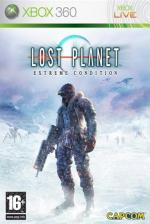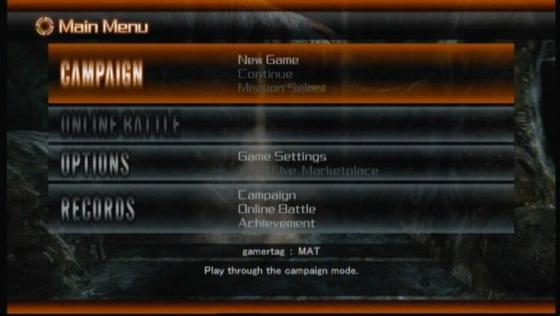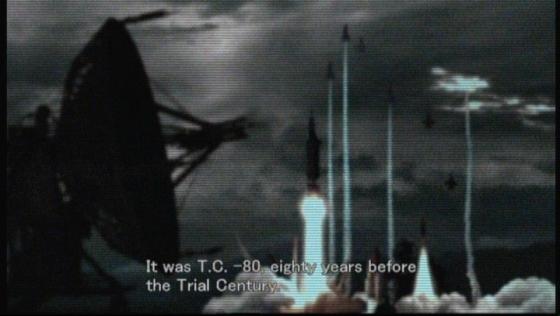
Gaming Age
 26th January 2007
26th January 2007
Author: Ernie Halal
Publisher: Capcom
Machine: Xbox 360 (EU Version)
Lost Planet: Extreme Condition
Capcom is known for a lot of things. Resident Evil, Streetfighter, Mega Man, and, recently, Dead Rising, are just examples of Capcom's expertise. Action shooters with online multiplayer are not on that list, so when Capcom announced and started a serious marketing campaign for Lost Planet, there was immediate buzz.
The title refers to a planet chosen for colonization which is also home to a touchy race of giant insects. The big creepy crawlies, known as Akrid, want the humans off their frozen godforsaken rock. After the colonists realize the Akrid produce an energy source which is usable once you kill them, they decide to stick it out.
The main character, Wayne, watches his beloved father die at the hands of a giant insect with the name "Green Eyes," and if anyone's wondering how this one giant alien got the personalization of a name, you're not alone. The son wakes up from the battle with very little memory of his life and in the care of a small group of people with extremely limited resources for a group stranded in the middle of a frozen wasteland. All they know is they need him to fight a series of missions using what little equipment they can provide.
Adding another dimension to the run and shoot expectations of a shooter, the world of Lost Planet makes use of mechs, referred to as VSs (short for Vital Suits). It's a good thing Wayne can remember how to drive, because his rescuers happen to have a VS handy.The setup to the game is brief and concise to get you into the action quickly. The cut scenes don't linger, they're well paced and over before you have a chance to get bored. At first, the story feels thinner than the ice on a pond in December (for those raised in the tropics - that's thin). Some details do get fleshed out along the way, as Lost Planet uses the time-tested amnesiac-as-protagonist plot device to full effect, but there's still not much depth or background to the action.
The bleak landscapes of Lost Planet provide an immediate connection to world that, at the very least, stands out from most other games. Vast expanses of snow, occasionally broken up by abandoned and not-so-abandoned structures, stretch as far as the eye can see, and each one leaves you feeling more isolated and endangered than the last. Snow ranges from simply crunching beneath your feet to more than knee deep, and even though the scenery involves lots and lots of white, it doesn't get old. There are enough hills, mountains and equipment laying around to keep the trek interesting. The only drawback is lack of room for exploration. While not exactly on rails, Lost Planet steers you in one direction at a time. If you have trouble finding a data point (the in-game excuse for figuring out which way to go - they point in the right direction when you turn them on), just walk around and you're bound to be blocked by imaginary walls pretty quickly. There really is only one way out.
Wayne starts off with two important pieces of equipment, a machine gun and s grappling hook. The hook can be fired at many high points - buildings, stairways, beams, etc - and it automatically propels you up, Batman style. It won't work on every piece of scenery, but it's a nice, believable way to add another dimension to the action when it is an option.The machine gun speaks for itself, as do the shotgun and hand grenades, plenty of which you'll find strewn about the tundra very early. Shotguns are always a trusted companion for bad guys that get in your face, but the shotgun in Lost Planet is particularly satisfying. By the time you stumble upon rocket launchers, gatling guns and laser guns, you'll realize you can only carry two weapons at a time. Whenever a game chooses this route, the first reaction is always sadness. These weapons never hurt anybody (their owners did), why should they be left in the cold? But it's an excellent design choice that forces risk/reward decisions.
The mechs are what any mech-user would expect. Bigger, sturdier, but clumsier versions of body armor than can carry bigger guns and therefore are indispensable in many situations. They vary slightly - some can hover and jump very high, some have a devastating blade attachment - and the longer you go, the more you'll need to get used to using them.
The single player missions are lent a sense of urgency by the need to constantly collect T-eng, or thermal energy. Your T-eng is constantly counting down, keeping you warm, it seems. You collect more from dead Akrid and destroyed heat sources, like gas barrels and vehicles. As long as your meter stays full, you'll recover health almost immediately. If your T-eng runs out, you're suddenly very vulnerable and not long for this cold world. The end result is a system that ranges from annoying - because you're motivated to look around less and move quickly through the game - to not noticeable if you play efficiently.The Akrid and other human obstacles make up for a brisk campaign, even if the formula is relatively known and boss battles plentiful. The action is never dull, even once you get the hang of the various species of Akrid and their habits. And the mech fights, along with excellent settings (it's not all snow) and rich graphics keep the experience interesting and fun. Explosions are done extremely well, and if you're too close to your target when you blow something up you won't be able to see through the very realistic smoke until the haze clears. Unfortunately, the bad guys don't have much trouble finding you.
The multiplayer games on Live include deathmatch, post grab (teams work to control data points) and all vs. one, but options for the host are almost nonexistent. Once you start a game, you can't change maps. You had the option for picking one game type and one map at the beginning or leaving it up to chance and setting everything to 'random.' And once you're in a game, you're in it without a way to quit before it's over. Additionally, many games end with no statistical evidence that they ever happened, which is a problem in a game that tracks online stats. It's difficult to be motivated if more than half of your stats never get recorded. Reviews often refer to features or parts of games that, "feel slapped on," as an afterthought. That's either true in this case or someone made several premeditated and horrible design decisions. Decisions which leave little hope the number of regular online players in Lost Planet will do anything but decline with time.
Hopefully Capcom will keep making shooters, because Lost Planet is fun and looks great. There are downsides, like the Akrid's lack of any sense of self-preservation (and strict attack patterns) and a heavy dependence on mechs which are not as much fun to control as in other, mech-centric games. But the biggest drawback is the lack of options and reliability in online multiplayer, which may hurt the game's long term popularity. If that's the case, a lot of people will be missing out on a unique single player campaign. Hopefully the new, interesting and unique identity established by Lost Planet can be fleshed out with a deeper story and better multiplayer in the future.
Other Xbox 360 Game Reviews By Ernie Halal
Scores
Xbox 360 Version| Overall | 75% |















